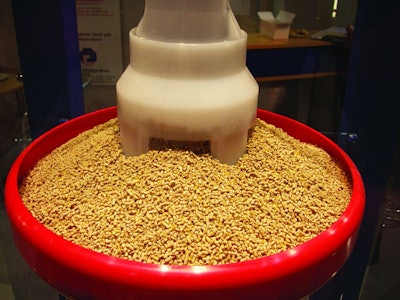
Ingredient selection is an important part of broiler feed production, and the right choice is essential for good broiler performance. Considerations should include the cost and the safety of ingredients, and implementing a quality assurance (QA) program is essential.
When choosing ingredients, consider the following:
1. Nutritional aspects
Nutrient values are important for ingredient selection. Typically, the focus is on incoming ingredients’ composition in terms of moisture, crude protein, fat, fiber and ash.
However, nutrient bioavailability, including metabolizable energy, digestible amino acids, fatty acids, available phosphorus and other nutrient values should also be considered. Many references are available for guideline values.
The nutrient matrix is very important for feed formulation, and the precision and accuracy of the analyses will affect the feed’s structure, cost and chemical composition.
The nutrient matrix of each ingredient can be influenced by season, source and storage time. For example, the starch content in cassava is lost during storage. The longer the storage, the more starch and energy will be lost. Nutrient matrices for each ingredient must be frequently evaluated and separated by sources.
Anti-nutritional factors are compounds that can interrupt nutrient absorption and metabolism and negatively impact health; and they can be found in a variety of ingredients. Their adverse impact can, however, be alleviated by physical, chemical and biological processes. The limited inclusion of ingredients is another option to reduce the risk of anti-nutritional factors.
2. Economic aspects
Sufficient supply of ingredients must be considered prior to evaluating their cost and nutritional value. Generally, supply and price vary depending on the season.
At times, it may be necessary to find a cheaper alternative to replace a higher-priced ingredient without reducing broiler performance. For example, soybean meal may be partially replaced with alternative protein sources, such as canola and rapeseed.
Enzyme application can not only alleviate the effects of anti-nutritional factors but reduce feed costs by releasing nutrients from the feed matrices.
Some enzymes, however, may not tolerate heat treatment during the feed production process. Although post-pellet liquid application systems can be used to circumvent heat sensitivity, enzyme recovery and uniformity in the final feed must be monitored regularly.
Relative value (RV) is the one tool that can determine the nutrient value of ingredients by comparing standard nutrients, such as crude protein, digestible amino acids, metabolizable energy or available phosphorus among ingredient sources.
3. Feed safety and regulatory aspects
Feed ingredients must be from safe sources. Nevertheless, safety assessments with testing and auditing are prudent to reduce the risk of feed contamination.
Hazards in feed ingredients are somewhat dependent upon the ingredient sources and processing types. Ingredient hazards can be classified into three main groups: chemical, biological and physical.
QA methods and standards must be used for ingredient selection to minimize these hazards. The QA process starts at ingredient purchasing by setting standards and conducting ingredient quality checks at reception in feed mills.
The inspection of ingredients must be in place to ensure all newly arrived ingredients are safe to use. Sampling and analysis must be rigid and precise. Sampling should be suitable for the volume and nature of ingredients, and methodology should be ingredient appropriate. Additionally, a monitoring program must be efficiently scheduled and suitable.
Feed safety must comply with the requirements of regulatory agencies. National and international regulations must be considered as criteria for ingredient selection, particularly export and import requirements.

4. Feed processing and pellet quality
Ingredients also impact the feed mill performance and pellet quality. The varying content and type of starch in ingredients require different levels of conditioning to achieve gelatinization. Moreover, different inclusions of starch-rich ingredients require optimal die sizes to produce good, high quality pellets, while maintaining efficient production capacity.
Other factors that can affect pellet quality and feed processing are fat and fiber content in ingredients. Fat is a necessary nutrient, but it also acts as a moisture barrier. Consequently, steam cannot be transferred to make the optimal gelatin. Fiber can reduce the capacity of the feed mill process and can cause equipment wear due to the abrasive properties.
Top tips for feed and water management in broiler houses
















